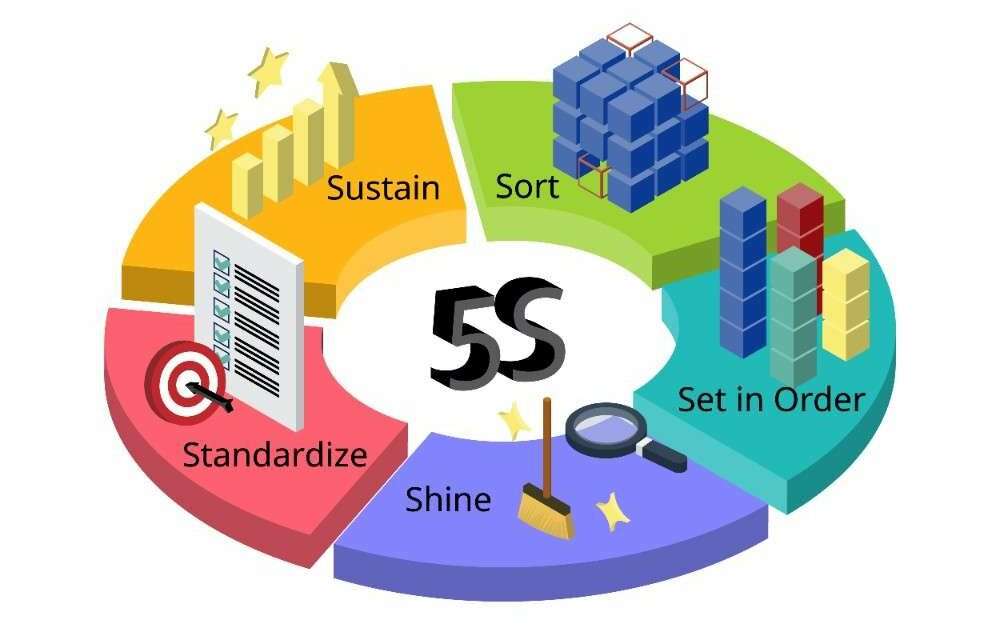
Maintaining an organized workspace is crucial for efficiency, productivity, and success in today’s fast-paced business world. One popular method for achieving an organized workspace is implementing the 5S system. This system, derived from the Japanese words seiri, seiton, seiso, seiketsu, and shitsuke. It focuses on sorting, setting in order, systematic cleaning, standardizing, and sustaining discipline.
By embracing the 5S system, businesses can create an environment that promotes order, cleanliness, and productivity. This article will explore the various benefits of a 5s in the workplace and provide signs of why companies need to implement this system.

1. Sorting (Seiri)
The first step in the 5S system is sorting, which involves removing unnecessary items from the workspace. This process helps declutter the area and ensures that only essential tools and materials are easily accessible.
By eliminating clutter, employees can save time searching for items and reduce the risk of injuries caused by tripping over objects. Besides, a clean and organized workspace fosters a sense of pride and professionalism.
Everything in its designated place makes the workflow smoother, leading to increased productivity and output.
2. Setting In Order (Seiton)
Once the sorting process is complete, the next step of 5s in the workplace is setting in order. This involves arranging the remaining items logically and efficiently. By designating specific locations for tools, equipment, and documents, employees can easily find what they need when they need it.
This organized approach reduces wasted time and promotes a smooth workflow. It also enhances the overall visual appeal of the workspace, creating a positive impression for clients and visitors.
3. Systematic Cleaning (Seiso)
Regular cleaning is a vital component of the 5S system. Businesses can maintain a hygienic and safe workspace by incorporating systematic cleaning into daily routines.
This includes dusting, sweeping, disinfecting surfaces, and regularly cleaning equipment and machinery.
Not only does systematic cleaning reduce the risk of accidents or equipment malfunctions, but it also improves employee morale by ensuring a pleasant and healthy work environment.
4. Standardizing (Seiketsu)
To maintain the effectiveness of the 5S system, it is crucial to establish standardized practices. This involves creating guidelines and procedures for maintaining an organized workspace.
By clearly documenting these standards, businesses can ensure consistency and accountability. Regular audits and inspections can be conducted to identify deviations from the established criteria, allowing for timely corrections.
Standardizing processes promotes efficiency, reduces errors, and fosters a culture of continuous improvement.
5. Sustaining Discipline (Shitsuke)
The final step in the 5s in the workplace system is sustaining discipline. This requires ongoing commitment from all employees to adhere to the established standards and practices.
Regular training sessions, reminders, and incentives reinforce the importance of maintaining an organized workspace.
By instilling a sense of responsibility and discipline, businesses can drive long-term success and create a culture of excellence.
Why Is 5s Important?

An organized and efficient workplace is crucial for the success of any company. 5S is a systematic approach to workplace organization that focuses on creating and maintaining an organized, clean, and efficient work environment. However, how one knows when a company needs 5s in the workplace? Take a look:
1. Cluttered And Disorganized Workspaces
A cluttered and disorganized workplace is a breeding ground for accidents and injuries. If employees need help finding tools, documents, or supplies due to a lack of organization, it can severely impact productivity and efficiency.
Implementing 5S can help create a systematic approach to organizing workspaces, ensuring that everything has a designated place and is easily accessible.
2. High Levels Of Waste
Another sign that a company could benefit from the 5s of workplace organization is the presence of high levels of waste. Waste can come in many forms, including excess inventory, unnecessary movement, and inefficient processes.
By implementing 5S, companies can identify and eliminate waste, leading to cost savings and improved efficiency.
3. Safety Hazards
If a company has many safety hazards or near misses, it may indicate that 5S workplace organization is needed. Cluttered workspaces, unorganized storage areas, and blocked emergency exits can all contribute to accidents and injuries.
Implementing 5S can help create a safer work environment by properly storing, labeling, and organizing everything. Also, properly storing and organizing hazardous materials ensure they are handled safely, minimizing the potential for accidents or exposure to harmful substances.
4. Inefficient Workflows
Inefficient workflows can lead to bottlenecks, delays, and decreased productivity. If employees constantly search for tools, wait for materials, or deal with unnecessary steps in their work processes, it’s a sign that 5S workplace organization is needed.
Companies can streamline processes and improve overall productivity by analyzing and optimizing workflows. Standardizing procedures and work instructions further enhances efficiency, ensuring tasks are done consistently and effectively. With a streamlined workflow, productivity increases, and waste is minimized.
5. Lack Of Employee Engagement
If employees are disengaged and lack motivation, it may be a sign that the workplace needs organization and improvement. A messy and disorganized workplace can create a sense of chaos and frustration among employees. It can lead to decreased motivation, increased stress, and a hostile work environment.
Implementing 5S can help create a clean, organized workspace that promotes employee engagement and satisfaction. Employees feel more in control of their surroundings and can focus on their work without distractions. This, in turn, boosts morale and creates a positive workplace culture.
6. Customer Care
A clean and organized workplace is conducive to maintaining high-quality standards. Implementing the 5s in the workplace system creates an environment where defects and mistakes are easily identified and addressed.
Tools and equipment are regularly inspected and maintained, ensuring optimal performance and preventing breakdowns that can lead to defective products or services. With a focus on quality, customer satisfaction is enhanced, leading to improved business outcomes.
Conclusion
The importance of a 5S-organized workspace cannot be overstated. By implementing the 5S system, businesses can create an environment that fosters efficiency, productivity, and success. Embracing these principles will ultimately contribute to improved business operations and online visibility.
Read more: The Power of Kaizen in Lean Manufacturing

